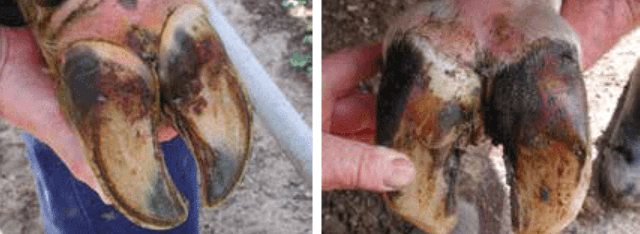A detailed look at two of the most commonly seen causes of lameness on the West Coast.
Continuing on with our lameness theme started in the last newsletter, we will look at two of the most commonly seen causes of lameness on the West Coast:
Foot rot
Cows are incredible animals, but one thing that they lack are opposable thumbs. This means that when annoying little stones get stuck between the claws of their feet, there is no way for cows to easily get them out on their own.
These little stones start off as just very irritating (like having something in your shoe), but as time goes on, they can cause more and more damage. They put pressure on the soft inside (abaxial side) of the toe, leading to damage of the skin and allowing bacterial infection to penetrate the tissue. This is what causes the bad smell and can lead to a large amount of swelling.
The pressure can also affect the horn growth from the coronary band and this is a major cause of abaxial cracks/defects (cracks on the horn between the toes). These are very annoying places to try and trim feet!
Treatment
If you catch it early enough, the easiest way to prevent disease is to simply remove the stone. Doing this as soon as it is first noticed will require no drugs, with no withdrawals and the cow should walk much more easily straight away.
On the other side of the coin, if you don't spot the stone and the foot swells, this will require a lot more drugs and time to come right.
When using antibiotics, I do not give penicillin for infected feet to cows unless their foot is swollen and I cannot see the creases in the feet any more.
Nine times out of 10, this rule of thumb works well and lowers the antibiotic usage on farms. If they do have penicillin, it is good to also give a shot of pain relief - either Metacam or Ketomax (this option has a nil milk withhold, which will allow you to keep the milk in the vat).
White line disease
The 'white line' is the area where the horn, which grows from the coronary band, connects onto the softer sole horn, which grows from beneath the foot.
White line disease (WLD) is when a defect forms in the area and can cause a small crack, which then keeps growing as it gets more impacted.
As time goes on, this defect can work its way higher and higher up underneath the horn wall until, in most cases, it bursts out of the top of the coronary band, just below the hairline.
In severe cases, instead of bursting, the infection goes inwards and leads to severe joint infection and boney, arthritic changes which, once formed, are impossible to remove and the cow would require a toe amputation.
Causes
The main cause of WLD is excessive turning and traction pressures on the hoof, exacerbated when the animal is on concrete. This can be caused by
excessive use of the backing gate - pushing all the animals too close and tight;
pushing them too hard when moving herds. Keep an acceptable distance when following on a bike. Dogs are not needed for moving dairy cows;
any tight corners where a cow has to turn at least 90 degrees on one spot, causing a pivoting action on at least one foot.
Treatment
Remove all underrun compromised horn. This generally means following the line all the way back until you can no longer see any black defects.
A big rule of lameness is to remove all underrun horn, as this acts as a pocket for dirt, grit and bacteria that just keep extending the hole and causing pain.
Be cautious
It is always better to do too little than too much! You can always pick up the foot again on another day, but if you cut off a chunk of foot, no amount of bandage is going to reattach any that.
Unless the foot is swollen and you can't see the lines (just like the foot rot treatment), antibiotics should not be needed.
However, taking away the wall means you are taking away the cow's weight-bearing surface, so she will need a block on the good toe to raise the sore one off the ground, along with 10ml of Ketomax pain relief and an anti-inflammatory, which can be given for 3 days.



